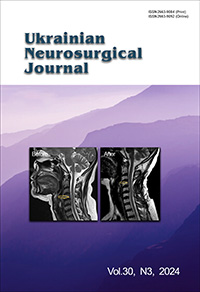Meningocele manqué. Case report of a rare disorder
DOI:
https://doi.org/10.25305/unj.306743Keywords:
meningocele manqué, spinal dysraphism, tethered cord, lipomyelomeningoceleAbstract
A case of meningocele manqué with its management is presented and the literature of this rarely reported condition is reviewed.
A one-year-old child was admitted with a small sac like lesion in the upper dorsal region with a soft swelling in the dorso lumbar region, was also associated with congenital bilateral talipes equinovarus which was being treated by a paediatric orthopedic surgeon.
Methods. Craniospinal MRI was suggestive of dorso lumbar lipomyelomeningocele, and corresponding to the dorsal sinus/sac at DV3/DV4 level there was another tethering seen on the MRI due to a band and associated with syrinx of the dorsal cord below that, s/o meningocele manqué.
Treatment. This patient underwent in 1st stage, DV2 to DV5 laminoplasty, excision of the sinus, durotomy, dissection of the multiple arachnoid cysts, and cutting of the dorsal band. In second stage will undergo surgery for Lipomyelomeningocele
Conclusion: Meningocele Manque is rare, it can present in isolation or associated with other spinal dysraphism. With other spinal dysraphism they can be either at the same or at another location, as was seen in our case. Before operating all cases of spinal dysraphism it is of paramount importance to MRI screen the entire neuraxis and study images thoroughly. In our case along with the dorso lumbar lipomyelomeningocele, there was a Meningocele manqué at DV3/DV4 level. It is essential that the meningocele manqué be addressed first; if not the returning/recoiling cord after de-tethering at the lower level can get tugged/sheared at the tethered meningocele manqué causing deficits.
References
1. Kriss VM, Kriss TC, Warf BC. Dorsal tethering bands of the meningocele manque: sonographic findings. AJR Am J Roentgenol. 1996 Nov;167 (5):1293-4. [CrossRef] [PubMed]
2. Kaffenberger DA, Heinz ER, Oakes JW, Boyko O. Meningocele manqué: radiologic findings with clinical correlation. AJNR Am J Neuroradiol. 1992 Jul-Aug;13 (4):1083-8. [PubMed][PubMed Central]
3. JAMES CC, LASSMAN LP. Spinal dysraphism. An orthopaedic syndrome in children accompanying occult forms. Arch Dis Child. 1960 Aug;35 (182):315-27. [CrossRef] [PubMed][PubMed Central]
4. Iskandar BJ, Oakes WJ, McLaughlin C, Osumi AK, Tien RD. Terminal syringohydromyelia and occult spinal dysraphism. J Neurosurg. 1994 Oct;81 (4):513-9. [CrossRef] [PubMed]
5. Lassman LP, James CC. Meningocoele manqué. Childs Brain. 1977;3 (1):1-11. [CrossRef] [PubMed]
6. Warder DE. Tethered cord syndrome and occult spinal dysraphism. Neurosurg Focus. 2001 Jan 15;10 (1):e1. [CrossRef] [PubMed]
7. Artul S, Nseir W, Artoul F, Bisharat B, Habib G. Atretic meningocele: Etiopathogenesis, frequency, anomaly associations and imaging findings. Austin J Radiol. 2015;2 (1):1011. https://austinpublishinggroup.com/radiology/fulltext/ajr-v2-id1011.php
Published
How to Cite
Issue
Section
License
Copyright (c) 2024 Ajay Sebastian Carvalho, Vijay Kumar Gupta, Chinmaya Srivatsava, Deepak Dwivedi

This work is licensed under a Creative Commons Attribution 4.0 International License.
Ukrainian Neurosurgical Journal abides by the CREATIVE COMMONS copyright rights and permissions for open access journals.
Authors, who are published in this Journal, agree to the following conditions:
1. The authors reserve the right to authorship of the work and pass the first publication right of this work to the Journal under the terms of Creative Commons Attribution License, which allows others to freely distribute the published research with the obligatory reference to the authors of the original work and the first publication of the work in this Journal.
2. The authors have the right to conclude separate supplement agreements that relate to non-exclusive work distribution in the form of which it has been published by the Journal (for example, to upload the work to the online storage of the Journal or publish it as part of a monograph), provided that the reference to the first publication of the work in this Journal is included.









